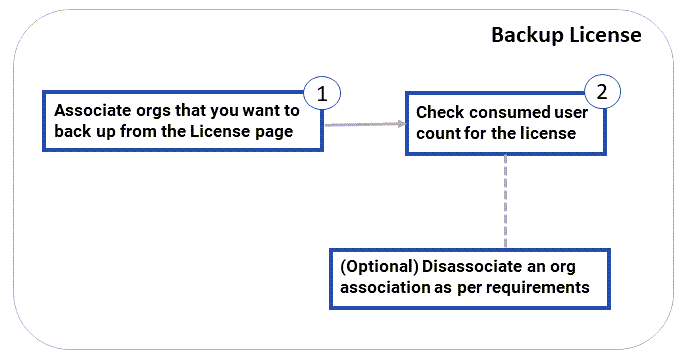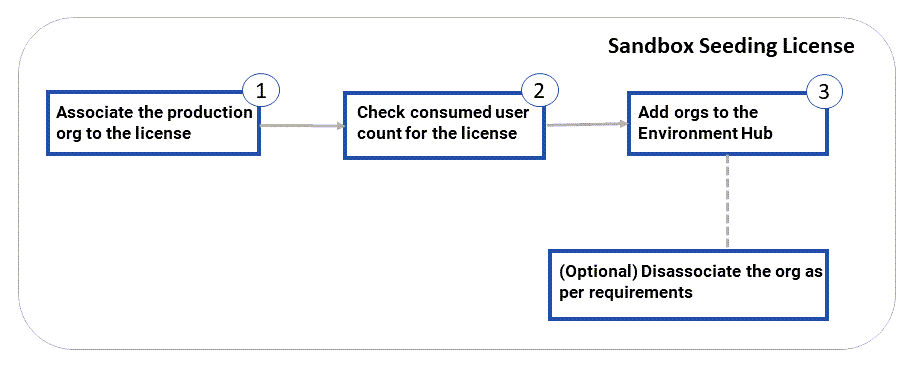Licensing Details
Overview
This article explains license management for the Salesforce App.
Check the License matrix to review the feature support available with each license type.
The Salesforce App associates active users with Standard Salesforce user type to a license, which includes Salesforce Platform and Salesforce Platform One user licenses.
To view and manage licenses within the Salesforce App, check license details.
License Types
Salesforce App provides the following license types for backup and sandbox seeding features:
- Enterprise License for Backup
- Elite License for Backup
- Sandbox Seeding
Check the License matrix to review the feature support available with each license type.
License matrix
The following license matrix explains the features available as per the licensing. For more information on licensing, contact Support.
|
Feature |
Enterprise License for Backup |
Elite License for Backup |
Sandbox Seeding License |
Archiver |
|---|---|---|---|---|
|
Restore Data using Data Restore Template |
* Limited to Backup Restore template |
* Limited to Backup Restore template |
* Limited to Data Copy template |
* Limited to Archival Restore template |
|
Data Masking using Data Restore Template settings |
|
|
|
|
|
Copy Data using the Data Copy Template |
|
|
|
|
|
Multi-region support |
|
|
|
|
|
Subject Access Requests for GDPR Compliance |
|
|
|
|
|
High-Frequency Backup |
|
|
|
|
|
Retention Period |
1 Year |
Unlimited |
- |
Unlimited |
|
Archiver Content SOQL Query Builder |
|
|
|
|
|
Data Deletion of Archived Records form source org |
- |
- |
- |
|
For more information about supported regions, contact Support.
Environment icon
The following icons help you identify the licenses associated with your Environment Hub.
| Icon | Description |
|---|---|
 |
Backup Definition |
 |
Archival License |
 |
Backup License |
 |
Seeding License |
 |
Data Template |
 |
Archival Definition |
Note: When you share an environment with others users; the shared users will not be able to view the associated licenses in Usage section under Environment hub section.
Licensing considerations
Review the following considerations when associating an org to a backup or sandbox seeding license:
Backup Licenses
You need to associate a production org or a full sandbox to backup licenses. The following workflow applies to a backup license: Enterprise or Elite.

Step 1: Associate orgs that you want to back up
Ensure that you associate every org that you want to back up to the backup license. To back up a sandbox, associate the sandbox to the license. For more information, see Authenticate Production Organization.
Step 2: Check license consumption
Ensure that the license consumption is within the limits of your procured user license limit.
Example:
- Suppose you have procured a backup license that includes a user limit of 500.
- Let’s assume you’ve associated an org A to the license with 400 users.
- If you want to add another org B to this license, ensure that the user limit does not exceed 100 users; otherwise, the app won’t allow you to associate org B.
For assistance with adding user limits to your backup license, contact your Account Executive.
Note: Starting December 30, 2023, you can authenticate 1 Full Sandbox to a backup license without impacting your production license count. This gives you more freedom to protect test and development sandboxes without concerns about license usage.
(Optional) Disassociate an org
Consider a scenario wherein you want to protect another org. In this scenario, you can disassociate an existing org from your backup license and associate with another org. However, you can do so only after completing 14 days of association with the current organization.
For more information, see Remove or Re-authenticate Organization Association.
Sandbox Seeding License
The following workflow applies to the Sandbox Seeding license.

Step 1: Associate orgs that you would use for data copy (sandbox seeding)
Suppose you have a production org that has sandboxes. You can associate the parent production org to a sandbox seeding license, that will automatically associate the related sandboxes. Or, you can associate the sandboxes only that you want to use for data copy.
For more information, see Authenticate Production Organization.
Step 2: Check license consumption
Ensure that the license consumption is within the limits of your procured user license limit.
Example:
- Suppose you have procured a sandbox seeding license that includes a user limit of 500.
- Let’s assume you’ve associated a production org to the license with 400 users.
- Suppose you want to associate another sandbox to this license, which is not a part of the associated production org. Ensure that the user limit does not exceed 100 users with this association; else, the app won’t allow you to associate org B.
The Salesforce App calculates the total licensed user count with the total Salesforce org users - Standard active users inclusive of Platform and Platform One users. If the count is lesser than or equal to the org users, you can associate other orgs to the license.
For assistance with adding user limits to your sandbox seeding license, contact your Account Executive.
Step 3: Add the orgs to the Environment Hub
It is important to add orgs to the Environment Hub; otherwise, you will not be able to specify an org in a data template.
For more information, see Configuring Environment Hub.
Archiver Licenses
You need to associate a production org to archiver licenses. The following workflow applies to these archiver licenses: Enterprise or Elite.

Step 1: Associate orgs that you want to archive
Ensure that you associate every org that you want to archive to the archiver license. For more information, see Authenticate Production Organization.
Step 2: Check license consumption
Ensure that the license consumption is within the limits of your procured user license limit.
Example:
- Suppose you have procured an archiver license that includes a user limit of 500.
- Let’s assume you’ve associated an org A to the license with 400 users.
- If you want to add another org B to this license, ensure that the user limit does not exceed 100 users; else, the app won’t allow you to associate org B.
For assistance with adding user limits to your archiver license, contact your Account Executive.
(Optional) Disassociate an org
Consider a scenario wherein you want to archive a different org. In this scenario, you can disassociate an existing org from your archiver license and associate with another org. However, you can do so only after completing 14 days of association with the current organization.
For more information, see Remove or Re-authenticate Organization Association.
View and manage the license details
You can view and manage the license details from the License page. You can see the following information:
|
Column |
Description |
|---|---|
|
License edition |
Specifies the type of license, which are as follows:
Click the arrow adjacent to the license edition listing to view the associated organizations and allocated users with a license. |
|
Expiration date |
Specifies the license expiration date. |
|
Assigned production organization |
Specifies the assigned production organization to the Salesforce App environment. |
|
Total allowed users |
Specifies the number of users associated with the license type. |
|
Feature type |
Specifies the particular feature type of the associated license. |
For more information, check the following resources:



